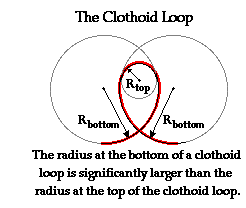There are several factors that allow roller coasters to complete loops. The speed that the roller coaster has built up is the most important factor. Without sufficient speed, the train will not make it up the incline of the loop, and it will not be able to complete it. The minimum speed that is needed for a train to complete a loop is called the critical velocity. The critical velocity is equal to the square root of the radius of the loop multiplied by gravity, or vc=(rg)^1/2. Without meeting this critical velocity, the train will not make it around the loop. If it is met, then the inversion will occur. Overcoming the friction of the track is very important, too. Some friction is good, as it keeps the wheels on the track, but too much will slow the train down too much and it will not be able to complete the inversion. Loops nowadays are not circular in shape, but clothoid in shape, as to reduce the force on the passengers at the bottom of the loop. This is done by the radius of the loop being much larger at the bottom of the loop compared to the top of the loop.
 Image from: http://www.physicsclassroom.com/class/circles/u6l2b.cfm |
 Image from: http://sarcasticlittlemiss.wordpress.com/category/uncategorized/page/8/ |